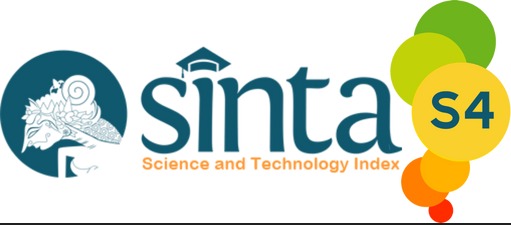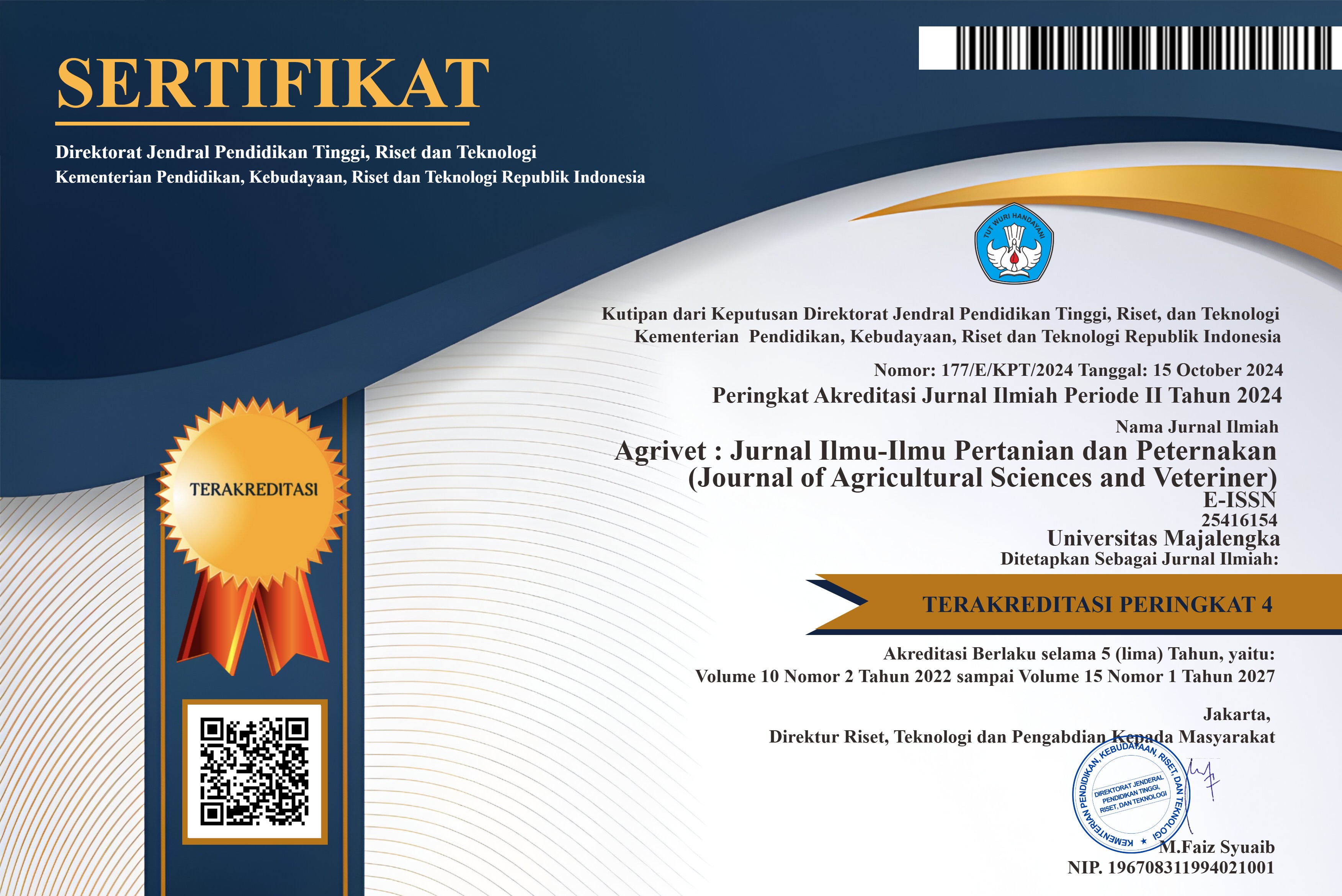Aplikasi mikroorganisme lokal bonggol pisang pada pertumbuhan dan hasil cabai merah (Capsicum annum L.) Varietas Gada F1
DOI:
https://doi.org/10.31949/agrivet.v11i1.6088Abstract
This study aims to determine the dose of banana weevil microorganisms that affect the growth and yield of red chili (Capsicum annum L.). Cultivar Gada F1. This research was conducted in the Bunder Block, Subang District, Subang Regency, Dangdeur Village, West Java Province. This research was conducted in September - December 2022. The experiment was conducted using the experimental method and the design used was a simple randomized block design (RBD) consisting of five treatments and each was repeated five times. Each plot had 6 plant populations planted in polybags and four plant samples, so the total population was 5 x 5 x 6 = 150. The treatment in this experiment consisted of: P1 (100 mL), P2 (125 mL), P3 (150 mL), P4 (175 mL), P5 (200 mL). The parameters observed in this study included: plant height, plant dry weight, fruit diameter, fruit length, fruit number and fruit weight. Dosage of banana weevil microorganisms affects the growth and yield of red chili plants, namely in the parameters: plant height, fruit length, fruit number, and fruit diameter. Dose of 200 mL/ Polybag produces the best amount of fruit.
Keywords: Local Microorganisms, Banana Weevil, Chili
Keywords:
Local Microorganisms, Banana Weevil, ChiliDownloads
References
Boraste, et al. 2009. Biofertilizers: A novel tool for agriculture. International Journal of Microbiology Research. Vol 1 Issue 2: 23-31.
Bozorgi HR. 2012. Effect of foliar spraying with marine plant Ascophyllum nodosum extract and nano iron chelate fertilizer on fruit yield and several attributes of eggplant (Solanum melongena). J. Agr Bio Sci. 7(5):357-362.
BPS https://www.bps.go.id/indicator/55/61/1/produksi-tanaman-sayuran.html. Diakses pada 6 Juli, 2023, 13.28.
BPS https://databoks.katadata.co.id/datapublish/2023/06/22/konsumsi-cabai-besar-dan-rawit-2022-sudah-melampaui-capaian-sebelum-pandemi. Diakses pada 22 Juni 2023.
Budiyani, N.K dan Soniari, N.N 2016. Analisis Kualitas Larutan Mikroorganisme Lokal (MOL) Bonggol Pisang Jurnal Agroteknologi Tropika 5(1): 63-72.
Cecagno, et al. 2014. The Plant Growth-Promoting Bacteria Azospirillum amazonense: Genomic Versatility and Phytohormone Pathway. BioMed Research International. Vol 2015. 1-7.
Firmansyah, Imam. Muhammad Syakir. Liferdi Lukman. 2017. Pengaruh Kombinasi Dosis Pupuk N, P, dan K Terhadap Pertumbuhan dan Hasil Tanaman Terung (Solanum melongena L.) Jurnal J. Hort Vol. 27 No. 1: 69-78.
Gardner, Franklin P., Pearce B. dan Mitchell. 1991. Fisiologi Tanaman Budidaya. Universitas Indonesia (UI-Press), Jakarta.
Hadisuwito, S. (2008). Membuat Pupuk Kompos Cair. Jakarta: PT Agromedia Pustaka
Kanchana, et al. 2014. Interaction effect of combined inoculation of PGPR on growth and yield parameters of Chilli Var K1 (Capsicum annum L.) International Journal of Microbiological Research. 5(3) 144-15.
Olaniyi. J.O and A. E. Ojetayo 2010. The Effect of Organomineral and inorganic fertilizers on the growth, fruit yield and quality of pepper (Capsicum frutescene L.) Journal of Animal and Plant Science Vol. 8 Issue 3: 1070-1076.
Sari, Diana Novita. S. Kurniasih. & R. Teti. 2012. Pengaruh Pemberian Mikroorganisme Lokal (MOL) Bonggol Pisang Nangka Terhadap Produksi Rosella (Hibiscus abdariffa L.)
Setiadi. 2011. Bertanam Cabai di Lahan Pot. Penebar Swadaya. Jakarta.
Suhastyo, Arum Asriyanti. 2011 Studi Mikrobiologi dan Sifat kimia Mikrobiologi Lokal (MOL) yang digunakan pada budidaya padi metode sri. Tesis pasca sarjana. Institut pertanian Bogor, Bogor.
Sukriming, S 2016. Pemanfaatan Limbah Bonggol Pisang Sebagai Mikroorganisme Lokal (MOL) Untuk Pertumbuhan dan produksi cabai.
Sutaryat, Alik dan S. Suparyono. 2011. Sumber hara. Trubus.504:119
Published
How to Cite
Issue
Section
License
Copyright (c) 2023 Nine Wahyuni Maulani

This work is licensed under a Creative Commons Attribution-ShareAlike 4.0 International License.
An author who publishes in the Jurnal Agrivet agrees to the following terms:
- Author retains the copyright and grants the journal the right of first publication of the work simultaneously licensed under the Creative Commons Attribution-ShareAlike 4.0 License that allows others to share the work with an acknowledgment of the work's authorship and initial publication in this journal
- The author is able to enter into separate, additional contractual arrangements for the non-exclusive distribution of the journal's published version of the work (e.g., post it to an institutional repository or publish it in a book) with the acknowledgment of its initial publication in this journal.
- The author is permitted and encouraged to post his/her work online (e.g., in institutional repositories or on their website) prior to and during the submission process, as it can lead to productive exchanges, as well as earlier and greater citation of the published work









